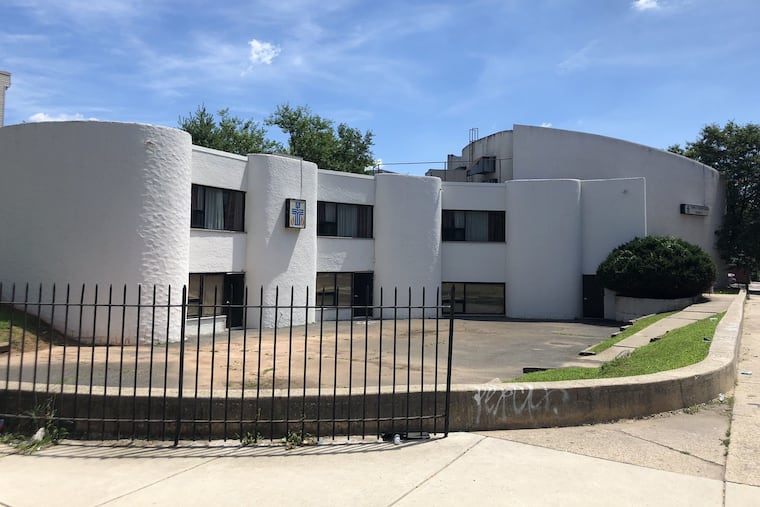How did this curvy modernist building end up in North Philadelphia in the ’60s? | Inga Saffron
This Presbyterian church is unlike anything else in Philadelphia.

The 1960s were a period of exuberant trial and error for architects. Eager to escape the straight lines and dour functionalist obligations of strict modernism, some turned to classical icons for inspiration. Others looked to nature and played around with organic forms.
In North Philadelphia, which was then beginning its struggle with de-industrialization and population loss, there was probably more demolition than new construction during that decade. Yet somehow, one of those lighthearted exercises managed to get built amid the rows of dark-red rowhouses in the Ludlow section. That amoeba-shaped creature stands casually at the intersection of Franklin and Thompson Streets, just a block north of Girard Avenue. Slathered in white stucco, it doesn’t have a single straight wall and looks as if someone had transformed one of Alvar Aalto’s sinuous Savoy vases into a building.
Perhaps the most surprising thing about this curvy curiosity is that it was commissioned by an old-line Protestant church, Temple United Presbyterian. The congregation was founded in 1835, when the neighborhood was full of church-going Scots-Irish immigrants. They had been worshiping in a handsome, if unremarkable, Gothic-style building on that corner that was built around 1875.
By the 1960s, Temple United was down to 133 members and Ludlow was increasingly home to African Americans and Puerto Ricans, with clusters of Jewish and Chinese residents. Determined to adapt to the new demographics, the church opened its heavy Gothic doors to the neighborhood, hosting community meetings, Girl Scout troops, and other nonreligious events.
Temple United had a long history as a missionary church, supporting religious work in China and Korea. But with the neighborhood changing, many members believed that they should redirect their efforts locally. Gang violence had become a serious problem in Ludlow, as it had in other sections of the city. As part of its outreach, Temple United hired a black pastor, the Rev. Cordell Holland Sloan, and started holding Spanish-language services.
Still, some members believed that the church could do more, according to board minutes, which are archived at the Presbyterian Historical Society on Lombard Street. Temple United officials became convinced that they couldn’t carry out their new mission in Ludlow from their existing church.
Echoing an argument that is still made today by churches and museums hoping to boost attendance, members claimed that their dark Gothic building was a turn-off to young people. A few members began urging the board to replace it with a modern structure that looked more like a “community-oriented building.” When traditionalists balked, advocates maintained that the church’s identity should not be defined by tradition. “We are not planning a new building to serve our needs, but to serve the needs of Ludlow,” they wrote in a statement.
It’s not clear how the dwindling congregation found the money, but in 1967, Temple United hired two little-known Philadelphia architects, Abraham B. Eastwood Jr. and William G. Rebbeck, to design a replacement. There is little information available about either architect, so it’s not clear whether they had a record of cutting-edge design. Rebbeck lived in Haddonfield and served for many years on the Camden County Planning Board.
Within a year, Eastwood and Rebbeck had established the contours of the new church. The building was split into two parts: a two-story office section that embraced the corner of Franklin and Thompson Streets like a pair of open arms, and a slightly taller, sanctuary-auditorium in a windowless drum oriented toward the Seventh Street corner. To make the curving structure fit the site, the church acquired several house lots on Seventh Street. Ground was broken on the building on June 23, 1968.
The white stucco building sits in a sunken grove, slightly below the sidewalk level. The office portion is segmented into bays marked by thick rounded columns, while the sanctuary drum is balanced by a smaller drum on Franklin Street. You enter through red church doors facing Thompson Street. Although there is a large grassy area in the back, the front plaza was paved for parking.
The sculptural building is a striking contrast to the straight streets and plain rowhouses that surround it. The undulating form seems to be a nod to such Finnish modernists as Aalto and Eero Saarinen, who experimented with shapes inspired by the natural world. But the thick impasto of the church’s white stucco ties it back to the houses of such early modernists as Walter Gropius.
Almost as soon as the church opened — sometime in 1969 or 1970 — the hopes for greater engagement with the community were realized. Rev. Sloan, who was known in the neighborhood as “The Rev,” began holding Friday night dances in the church as a way of countering gang fights. The “teen canteen took precedence over Bible study,” church minutes observed. Sloan, who had been a civil rights activist in the South, emerged as an important peacemaker in Philadelphia, along with co-pastor Rev. Dennis J. Loo.
But the neighborhood continued to struggle, and by the 1990s, there were nearly as many vacant lots as rowhouses. In the last few years, as the housing boom has spread west from Fishtown, Ludlow has started to come back to life. New houses are filling in the gaps on Thompson and Seventh, once again providing a straight-edge frame to show off Temple United’s experimental curves, and perhaps a new constituency for its meeting rooms.